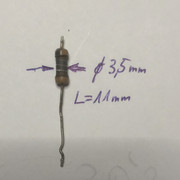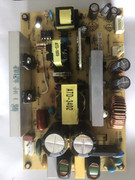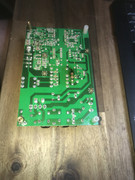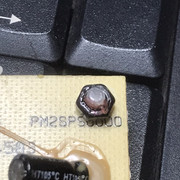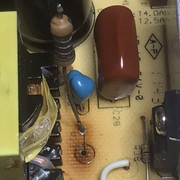|
|
Post by JerryP on Sept 21, 2015 10:25:09 GMT -5
Yes, that's good. Connect that adapter back on to the voltage regulator but leave the alligator wire still connected. But now connect the other end of the test wire to the positive lead of your DMM. Connect the negative DMM to a good ground on the motor, probably where the ground cable from the battery connects to. Set your DMM to DC volts. Now watch you DMM while you crank the engine. Depending on how fast the motor starts will determine how much voltage you will read but it should be at least 8 to 12 volts. Once it starts and is no longer cranking it will drop to zero volts. See what you get. I did the test you posted above. - Connect that adapter back on to the voltage regulator but leave the alligator wire still connected. - But now connect the other end of the test wire to the positive lead of your DMM. - Connect the negative DMM to a good ground on the motor, probably where the ground cable from the battery connects to. - Set your DMM to DC volts. - Now watch you DMM while you crank the engine. - Depending on how fast the motor starts will determine how much voltage you will read but it should be at least 8 to 12 volts. - Once it starts and is no longer cranking it will drop to zero volts. See what you get. I measured 2.8-3.0 volts on the DMM doing that test. Of course, my generator did not start (that is the problem), so that was during cranking. Is there a way I can excite the field winding and voltage regular with 12 volts (which is what I did when I managed to start the generator engine) and leave it that way without damaging anything which is apparently not already bad? I can connect a relay up so the coil connects to the starter side of the starter soleniod and ground, then connect the NO switch to the battery side of the starter solenoid and the switch 'common' to the terminals where those two wires are, this will put 12-13 volts to those wires only while cranking, then drop the voltage off when the generator starts and the starter solenoid is released. I'm not sure that will address the problem or not - I suspect the 'Engine Controller' circuit board is bad and I have not found a source for one as yet. |
|
|
|
Post by RVspecialist on Sept 21, 2015 14:28:46 GMT -5
I have to run out but I will respond when I return. It might be better if you register to the forum because i do not currently get notifications when you respond in the thread.
|
|
|
|
Post by jerryp on Sept 21, 2015 15:01:34 GMT -5
I connected a relay as I described so that it puts 'battery voltage' (only when cranking) on that voltage regulator terminal which also puts it on the field winding.
The problem is, when cranking, the voltage is only peaks at about 8-1/2 volts or so before dropping down to around 7 volts and not 12-13 volts - I can hear and feel it try to fire once or twice but that is all. I must have a poor connection to allow the voltage to drop that low from the 13+ volts I measure before cranking. It may also be that my screw driver is creating such a resistance only making point contact at the two terminals on each side of the start solenoid that the voltage drops that much because of that high resistance (the screw driver gets hot fairly quickly, and it is a rather large screw driver (in width of the blade and size of the shaft, not a dinky little one).
I may try a battery charger clamp clamping across those two starter solenoid terminals to see if that reduces the resistance of the connection (and would thus reduce the voltage drop across the resistance of the connection). But I'll wait to hear back from you first - I did register.
|
|
|
|
Post by RVspecialist on Sept 21, 2015 15:34:23 GMT -5
Ok, I have read through mostly everything you have posted and I want to start in 1 place and then go from there. So if I do not address any of your specific questions it is because that will come as we go along.
So when you say in your last post that you connected a relay that puts voltage on the regulator, do you mean it puts voltage on pin 13 of the control module?
|
|
|
|
Post by jerryp on Sept 21, 2015 19:22:19 GMT -5
So when you say in your last post that you connected a relay that puts voltage on the regulator, do you mean it puts voltage on pin 13 of the control module? On the voltage regulator, the 3rd wire from the top with the adapter with the two wires, the positive lead of the DMM to a good ground on the motor. That is where I was getting about 8-1/2 volts which then dropped to about 7 volts. You said, in another post, that depending on how fast the motor starts will determine how much voltage will be read but it should be at least 8 to 12 volts. I connected my battery charger to the battery side of the starter solenoid and chassis ground, and set it to 30 amp charge (too keep up with the starter motor draw as best possible). The voltage between the terminal on the voltage regulator with the adapter and the two wires, measured to chassis ground, read about 13-1/2 volts before cranking the engine, and about 9-1/2 volts while cranking before dropping to around 8 to 8-1/2 volts. What is the minimum voltage which should be at those wires to ground to get a spark? The manual says there should be 'battery voltage' on those wires, which I would interpret to mean about 12-13 volts. Those wires go back to pin J1-9 shown in the Diagnostic and Repair Manual, the wire is blue (all the wires there are blue) and has a number '4' on it. The manual shows that #4 wire going to the field winding and the voltage regulator. The manual shows J1-13 going to the starter motor and starter contactor. I may have measured the voltage at pin 13 when I was first checking voltages with my DMM, but I have not measure the voltage at pin 13 with the knowledge that I was measuring pin 13 or the voltage going to the starter motor - I just now traced pin 13 on the wiring schematic now to see where pin 13 goes to. I have not touched what looks to be an adjustment on the voltage regulator. |
|
|
|
Post by jerryp on Sept 21, 2015 19:32:29 GMT -5
I am making this a separate post to separate this from the information in my previous post.
I connected the relay coil to the starter motor side of the starter contactor and to ground so that cranking the generator will pull in the relay, and only when it is cranking.
I then connected the NO switch contact lead of the relay to the battery side of the starter contactor (to avoid any voltage drop across the starter contactor).
I then connected the 'common' switch contact lead to the third terminal down on the voltage regulator (the terminal which has the adapter and the two wires), and these wires should have 'battery voltage' on them during cranking to excite the field winding. This 'common' lead from the switch only has 'battery voltage' on it during cranking, which is what the #4 marked wire from J1-9 should have anyway (but does not).
When cranking, and only when cranking, the relay I added (temporarily added while working on this problem) pulls in and puts battery voltage to the voltage regulator on that terminal with the adapter and two wires, one of which goes to the field winding to excite the field on cranking.
But the most voltage I can get to the voltage regulator and the filed winding measures about 9-1/2 volts.
|
|
|
|
Post by RVspecialist on Sept 21, 2015 20:58:46 GMT -5
Ok, now you are just going all over the place. Slow down and take a deep breath, lol.  If the red led on the voltage regulator was lit when you last had it running means it was working properly and the generator was probably outputting power. So forget about that regulator for now. And by all means stop poking at it, haha. Sometimes things get broken from to much poking.  Now I am very meticulous when it comes to diagnostics which is why i am always successful. So I would like you to do what I ask and nothing else. Just short answers with your results. So why do you believe the starter relay is bad?  |
|
|
|
Post by jerryp on Sept 21, 2015 21:41:48 GMT -5
Ah-ha! In reviewing more of the manual I realized that I was testing things which do not matter ... to my problem! I have been looking at the generator components instead of the motor components, so ... You said: "Ok, now you are just going all over the place. Slow down and take a deep breath, lol.  " - You are absolutely correct, and I wasn't even playing in the right ballpark. You said: "If the red led on the voltage regulator was lit when you last had it running means it was working properly and the generator was probably outputting power. So forget about that regulator for now. And by all means stop poking at it, haha. Sometimes things get broken from to much poking.  " - Absolutely correct, I was in the wrong ballpark. You said: "Now I am very meticulous when it comes to diagnostics which is why i am always successful. So I would like you to do what I ask and nothing else. Just short answers with your results." - Sounds good to me, but - as I recall from yesterday - I had battery voltage on pin 4 and pin 5 as shown in the manual under Test 34 (I am now in the right ballpark - the engine instead of the generator. - I can check that tomorrow if you say to check it - it may save a few steps? You asked: "So why do you believe the starter relay is bad?  " - Because, even when the engine and generator were starting and running properly, the starter contactor would not always pull in and crank the engine from the switch on the generator but did from the remote switch inside (I realize that the switch on the generator could be bad or going bad), but then it got to where neither switch would pull the starter contactor in unless the motorhome engine was running and the voltage went up from the alternator. Not a sure thing that the starter contactor is bad, just the evidence lead to it. Do you want me to recheck Test 34 to verify that battery voltage is at pin 4 and pin 5? Or start with something else? If you could give me several steps and 'if this, check this, otherwise check this' at a time that would be good as I need to take the motorhome back to the storage lot tomorrow afternoon, which means I will need to continue checking out the generator at some other time (I may not be able to get back to it for another month or so).  I look forward to all of your help and guidance, Jerry |
|
|
|
Post by RVspecialist on Sept 21, 2015 22:18:35 GMT -5
What I have found over the years is that many times the problem is just a bad connection somewhere. Especially since it is mostly in the weather even if it is under the rig. And don't forget about ground connections. These are sometimes over looked.
Where your main battery ground cable is attached to the lug that is bolted to the generator, use your ohm meter and make sure you have a good connection between the cable wires and the generator frame. Then also test for low ohm reading from ground cable to the small connector on the starter relay (0). If ok then remove the other small wire (56) from the starter relay and then ohm test from ground wire to the small terminal you removed the wire from. If it reads somewhere around 2 to 25 ohms or close then reattach the wire and then ohm test from ground wire to pin J1-1 of the controller and see if reading is around the same. Also check for low ohm reading from ground wire to pin J1-12 of the controller and the center terminal of the start switch (SW1).
Let me know what you get.
|
|
|
|
Post by jerryp on Sept 22, 2015 10:45:59 GMT -5
I had to do some unplanned errands this morning which cut into my time for the generator.
1) Where your main battery ground cable is attached to the lug that is bolted to the generator, use your ohm meter and make sure you have a good connection between the cable wires and the generator frame.
- 0 to .1 ohms
2) Then also test for low ohm reading from ground cable to the small connector on the starter relay (0).
- 0 to .1 ohms
3) If ok then remove the other small wire (56) from the starter relay and then ohm test from ground wire to the small terminal you removed the wire from. If it reads somewhere around 2 to 25 ohms or close then reattach the wire
- 3.8 ohms
4) then ohm test from ground wire to pin J1-1 of the controller and see if reading is around the same.
- 3.8 ohms
5) Also check for low ohm reading from ground wire to pin J1-12 of the controller
- 0 to .1 ohms
6) [from ground wire to] the center terminal of the start switch (SW1).
- 0 to .1 ohms
Thank you,
Jerry
|
|
|
|
Post by RVspecialist on Sept 22, 2015 11:19:35 GMT -5
If you remove the small wire (56) from the relay and set it aside and then take a jumper wire (preferably one with an alligator clip) and attach it to the small terminal(56) and then touch the other end of the wire to the large lug on the starter relay with the battery postive (+), does the relay: click? and turn the engine over?
|
|
|
|
Post by jerryp on Sept 22, 2015 11:40:00 GMT -5
1) If you remove the small wire (56) from the relay and set it aside and then take a jumper wire (preferably one with an alligator clip) and attach it to the small terminal(56) and then touch the other end of the wire to the large lug on the starter relay with the battery postive (+), does the relay: click?
- Yes
2) and turn the engine over?
- No
- I checked voltage on the battery terminal side of the starter contactor (motorhome engine not running) = 11.5 volts
- I then checked the voltage on the starter motor terminal side of the starter contactor and (as expected, just verifying) = 0 volts
|
|
|
|
Post by RVspecialist on Sept 22, 2015 12:30:36 GMT -5
That battery voltage is to low, even though it also appears that the relay is bad. Battery voltage should be at least 12.6 so you may have a bad battery that even charging won't help. But lets do 1 more test but throw a charger on that battery if you can.
Take your test light and connect the clip to good ground. Then put probe on J1-1 which is for the relay wire you have disconnected. Leave it disconnected but make sure the end is not touching ground anywhere. Then press the start button(SW1) and see if your test light comes on.
Also, what is the voltage right on the battery?
|
|
|
|
Post by jerryp on Sept 22, 2015 13:39:49 GMT -5
1) That battery voltage is to low, even though it also appears that the relay is bad. Battery voltage should be at least 12.6 so you may have a bad battery that even charging won't help.
- Yesterday, the voltage at the battery terminal of the starter contactor was 13.5 volts when the motorhome engine was running.
2) But lets do 1 more test but throw a charger on that battery if you can. Take your test light and connect the clip to good ground. Then put probe on J1-1 which is for the relay wire you have disconnected. Leave it disconnected but make sure the end is not touching ground anywhere. Then press the start button(SW1) and see if your test light comes on.
- Yes, the test light comes on.
- The voltage at J1-1 measures 11.1 volts (just battery voltage, motorhome engine not running)
3) Also, what is the voltage right on the battery?
- 12.32 volts at the battery terminals
Another issue just resurfaced (it happened once last year too) - when I pressed the 'start' switch and the fuel pump came on to prime the engine (and this did not happen yesterday or the day before when I was trying to start it) gas came out the air filter ... indicating that the float needle valve stuck open. The day before yesterday, the float needle valve was stuck closed, I removed the carburetor, removed the float bowl, removed the float and needle valve, and debris came out of the float bowl and the needle valve - I suspect that debris has gone past my two filters and is blocking the needle valve from fully closing.
Now that I have this extra work to do - clean the debris out of the float bowl and try to make sure there is no more debris in the fuel lines between the filters and the carburetor - I guess I will need to pack it back together for today and finish it the next time I get several days to work on it.
I may also run a new conductor from the DC power supply panel directly back to the starter contractor to help eliminate voltage drop to the generator. I am thinking of running a #2 AWG in parallel with the existing conductor (but not necessarily alongside the original conductor as I might not be able to follow the original conductor's path) - do you think that is good or unnecessary?
After checking back for your answers for the above, I will be back in touch when I get my next chance to work on the generator,
Thank you for your help,
Jerry
|
|
|
|
Post by RVspecialist on Sept 22, 2015 14:34:00 GMT -5
At this point I think 2 things need to be addressed.
1) Change the battery, or at least try to fully charge it and let it set for 24hrs and see if it maintains at least 12.6v ...
12.32v is no good
2) Replace that starter relay.
I know you wanted to try to see if everything works before putting any parts in this but I don't think you realize what is not happening when you try to jump that relay. Even though when you are jumping that relay for the engine to crank and even though you are compensating by making sure you are sending battery voltage to pin J1-13 on the controller...... you are failing to temporarily ground pin J1-6 which actually aids in activating the controller. This could be why you had no spark when cranking the engine. In this type system, almost everything has to be working and in sync with each other or nothing works.
I think having a good battery in there and replacing that starter relay and everything will work fine.
|
|




